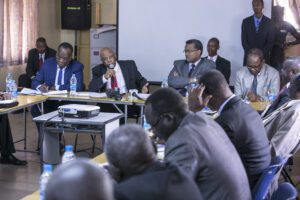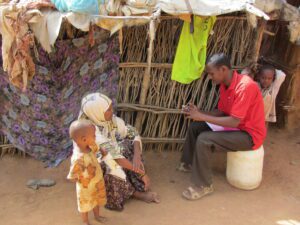In the intricate landscape of development and governance, understanding the true impact of programs and policies is not just desirable—it’s essential. For Uganda, a nation committed to progress and accountability, the ability to effectively monitor and evaluate its initiatives hinges on one fundamental element: robust data. High-quality data collection for M&E in Uganda serves as the bedrock upon which evidence-based decisions are made, resources are optimized, and sustainable development goals are achieved. Without credible data, Monitoring and Evaluation (M&E) efforts risk becoming speculative, hindering the ability to learn, adapt, and ultimately deliver meaningful results for the Ugandan people.
This comprehensive guide delves into the critical aspects of data collection for M&E in Uganda, exploring best practices, innovative tools, and the ethical considerations that underpin this vital process. Whether you are an M&E practitioner, a program manager, a policymaker, or a development partner, strengthening your understanding of data collection for M&E in Uganda is key to contributing to a more effective and accountable public and development sector.
Foundations of Effective Data Collection for M&E in Uganda
At the heart of any successful M&E framework lies a well-thought-out approach to gathering information. This begins with understanding the landscape of available methods and making informed choices.
1. What are the most commonly used data collection methods in M&E?
A diverse array of data collection methods M&E practitioners utilize, each with its strengths and applications. The most common include:
- Surveys: Perhaps the most widely used method, surveys involve collecting standardized information from a sample of individuals or households using questionnaires. These can be administered face-to-face, via telephone, online, or through mail.
- Interviews: In-depth interviews (IDIs) involve one-on-one conversations with key informants, beneficiaries, or stakeholders to gather rich qualitative insights. Semi-structured interviews, with a guide of open-ended questions, are common.
- Focus Group Discussions (FGDs): FGDs bring together a small group of people (typically 6-10) to discuss specific topics under the guidance of a skilled moderator. They are excellent for exploring group norms, shared experiences, and diverse perspectives.
- Observation: This involves systematically watching and recording behaviors, events, or physical characteristics in their natural setting. Observation can be participant (researcher is involved) or non-participant, structured or unstructured.
- Document Review: Analyzing existing documents such as project reports, official records, meeting minutes, policy documents, and media reports to extract relevant M&E data.
- Case Studies: In-depth investigations of a specific individual, group, organization, or project to provide a holistic understanding within its real-life context.
- Administrative Data Review: Utilizing routinely collected data from government ministries, departments, and agencies (MDAs) or other service providers (e.g., school enrollment, clinic attendance). Effective data collection for M&E in Uganda often leverages this existing information.
- Mapping and GIS: Using Geographic Information Systems to collect and analyze spatial data, visualizing project locations, service coverage, or environmental changes.
2. How to choose the appropriate data collection method for a specific M&E project?
Selecting the right data collection methods M&E depends on several factors, ensuring the approach is fit-for-purpose:
- M&E Questions: What specific questions does the M&E activity aim to answer? Different questions require different types of data (e.g., “how many?” vs. “why?” or “how?”).
- Type of Data Needed (Quantitative vs. Qualitative): Are you looking for numerical data to measure extent and establish statistical relationships (quantitative vs qualitative data M&E considerations are key here)? Or do you need in-depth narrative information to understand experiences, perceptions, and context? Often, a mixed-methods approach combining both is most powerful for robust data collection for M&E in Uganda.
- Project Context and Target Population: Consider the cultural context, literacy levels, accessibility of the target population, and their willingness to participate.
- Available Resources: Budget, time, and human resource capacity will significantly influence the feasibility of different methods. Large-scale surveys are more resource-intensive than FGDs.
- Sensitivity of Information: For sensitive topics, more private methods like in-depth interviews might be preferred over group discussions.
- Required Rigor and Credibility: The level of precision and generalizability needed will guide methodological choices.
- Timeline: Some methods, like longitudinal studies, require extended periods, while others can yield quicker results.
A thoughtful assessment of these factors is crucial for effective data collection for M&E in Uganda.
Strategic Approaches to Data Gathering
Once methods are considered, strategic planning for how data will be gathered from whom is essential.
3. What are the key considerations for designing a sampling strategy in M&E?
For many M&E activities, especially quantitative ones, collecting data from the entire population of interest (census) is impractical. Sampling involves selecting a representative subset. Key considerations include:
- Defining the Target Population: Clearly identify the group of people, households, facilities, or communities that the M&E findings should represent.
- Sampling Frame: Develop a list or map of all units in the target population from which the sample will be drawn. The quality of the sampling frame is critical for representativeness in data collection for M&E in Uganda.
- Sample Size: Determine an adequate sample size to ensure statistical power and precision. This often involves calculations based on the desired confidence level, margin of error, and population variability.
- Sampling Technique:
- Probability (Random) Sampling: Every unit has a known, non-zero chance of selection (e.g., simple random, systematic, stratified, cluster sampling). This allows for generalization to the wider population.
- Non-Probability Sampling: Selection is not random (e.g., purposive, convenience, snowball, quota sampling). Often used in qualitative research or when a sampling frame is unavailable, but limits generalizability.
- Representativeness: The sample should reflect the characteristics of the target population as closely as possible. Stratified sampling can help ensure representation of key sub-groups.
- Feasibility and Cost: The chosen sampling strategy must be practically implementable within the available resources.
- Ethical Considerations: Ensure the sampling process is fair and does not disproportionately burden or exclude certain groups.
Ensuring Credibility: Data Quality and Ethics
The value of M&E data is entirely dependent on its quality and the ethical manner in which it is collected.
4. How to ensure data quality in M&E data collection?
High-quality data is valid, reliable, timely, precise, complete, and has integrity. Strategies to ensure this during data collection for M&E in Uganda include:
- Clear Protocols and Standardized Tools: Develop well-defined data collection protocols and standardized, pre-tested instruments (questionnaires, interview guides).
- Enumerator Training: Thoroughly train data collectors on the objectives, methods, tools, ethical conduct, and potential challenges.
- Pilot Testing: Test data collection tools and procedures on a small scale before full implementation to identify and rectify any issues.
- Supervision and Monitoring: Provide regular supervision and monitoring of data collectors in the field to ensure adherence to protocols and address problems promptly.
- Data Verification and Validation: Implement checks during and after data collection. This can include back-checks, spot-checks, and consistency checks.
- Use of Technology: Digital data collection tools can incorporate built-in validation rules and skip patterns to reduce errors.
- Secure Data Management: Establish secure systems for data entry, storage, and backup to prevent loss or unauthorized access.
- Feedback Mechanisms: Create channels for data collectors to report issues and for data users to provide feedback on data quality.
5. What are the ethical considerations in M&E data collection, including informed consent and protecting vulnerable populations?
Ethical conduct is non-negotiable in data collection for M&E in Uganda. Key considerations include:
- Informed Consent: Participants must voluntarily agree to participate after being fully informed about the purpose of the data collection, what is expected of them, how the data will be used, potential risks and benefits, and their right to withdraw at any time without penalty. Consent should be documented (written or verbal, if appropriate for the context).
- Confidentiality and Anonymity: Protect the identities and private information of participants. Data should be anonymized where possible, and identifiable information stored securely and separately.
- Do No Harm (Non-maleficence): Ensure that the data collection process does not cause any physical, psychological, social, or economic harm to participants or communities.
- Beneficence: Strive to maximize potential benefits to participants and the wider community from the M&E process.
- Justice and Equity: Ensure fair selection of participants and avoid disproportionately burdening or excluding specific groups. Consider power dynamics.
- Protecting Vulnerable Populations: Take special precautions when involving children, refugees, persons with disabilities, or other groups who may be at higher risk or have diminished autonomy. This may require adapted consent procedures and more sensitive approaches.
- Data Security and Privacy: Implement robust measures to protect collected data from unauthorized access, use, or disclosure.
- Transparency: Be open about the purpose of the M&E and how findings will be shared.
- Cultural Sensitivity: Design and conduct data collection in a manner that respects local customs, traditions, and values. This is particularly important for effective data collection for M&E in Uganda given its diverse cultural landscape.
- Institutional Review Board (IRB) Approval: For research-oriented M&E involving human subjects, seeking approval from an IRB or ethics review committee may be necessary.
Tools, Technologies, and Techniques in Modern M&E
The M&E landscape is continually evolving with new tools and techniques to enhance efficiency and rigor.
6. What tools and technologies are available for M&E data collection, and how to use them effectively?
Technology has revolutionized data collection for M&E in Uganda:
- Mobile Data Collection (MDC) Apps: Tools like Open Data Kit (ODK), KoboToolbox, SurveyCTO, and SurveyMonkey allow for designing complex questionnaires and collecting data offline on smartphones or tablets.
- Effective Use: Ensure proper form design, robust training for enumerators, offline capabilities, data encryption, and regular syncing to a central server.
- Geographic Information Systems (GIS): Software like ArcGIS, QGIS, and Google Earth Pro enable the collection, management, analysis, and visualization of geospatial data.
- Effective Use: Integrate GPS coordinates into surveys, map project sites and beneficiary locations, and analyze spatial patterns.
- Cloud Storage and Collaboration Platforms: Services like Google Drive, Dropbox, and Microsoft SharePoint facilitate secure data storage, sharing, and collaborative work on M&E documents.
- Effective Use: Establish clear file management protocols, control access permissions, and ensure regular backups.
- Statistical Software: Packages like SPSS, Stata, R, and MS Excel are used for quantitative data analysis.
- Effective Use: Ensure data is clean and properly formatted; select appropriate statistical tests based on data type and research questions.
- Qualitative Data Analysis Software (QDAS): Tools like NVivo, ATLAS.ti, and MAXQDA assist in organizing, coding, and analyzing large volumes of qualitative data.
- Effective Use: Develop a clear coding framework; use the software to manage and explore data rather than as a substitute for critical thinking.
- Remote Sensing: Satellite imagery and drone technology can be used for monitoring environmental changes, agricultural land use, and infrastructure development.
- Effective Use: Requires specialized expertise for image acquisition and interpretation.
- Interactive Voice Response (IVR) and SMS Surveys: Useful for reaching populations with mobile phone access, especially for short, simple surveys.
Effective use of these tools for data collection for M&E in Uganda requires capacity building, appropriate infrastructure (e.g., internet access for syncing), and integration into existing M&E workflows.
7. What are the best practices for conducting interviews and focus groups in M&E?
Interviews and FGDs are vital for gathering qualitative data. Best practices include:
- Careful Planning: Define objectives, develop a clear interview/FGD guide with open-ended questions, and select participants purposively based on the information needed.
- Skilled Facilitation/Moderation: The interviewer/moderator should be well-trained, neutral, an active listener, able to build rapport, probe effectively, and manage group dynamics (for FGDs).
- Conducive Environment: Conduct sessions in a comfortable, private, and neutral location where participants feel safe to share openly.
- Informed Consent: Obtain informed consent before starting and ensure participants understand confidentiality.
- Effective Questioning: Use open-ended questions, avoid leading questions, use probes to elicit detail, and allow for silence.
- Active Listening: Pay close attention to verbal and non-verbal cues.
- Managing Group Dynamics (FGDs): Encourage participation from all members, manage dominant voices, and ensure a respectful exchange of views.
- Accurate Recording: Use audio recorders (with consent) and take detailed notes. For FGDs, a dedicated note-taker is often essential.
- Debriefing: After each session, the interviewer/moderator and note-taker should debrief to capture key insights and reflections.
- Transcription: Transcribe audio recordings verbatim for thorough analysis. This is a critical step in qualitative data collection for M&E in Uganda.
Making Sense of the Data: Analysis and Interpretation
Once data is collected, it must be analyzed to generate meaningful findings.
8. How to handle and analyze qualitative data in M&E?
Qualitative data analysis techniques M&E employ to make sense of rich, narrative information. The process is generally iterative:
- Data Preparation: Transcribe interviews and FGDs, clean notes, and organize the data.
- Familiarization: Read and re-read the data to get a deep understanding.
- Coding: Identify key themes, concepts, and patterns in the data. This involves assigning labels (codes) to segments of text. Codes can be deductive (pre-defined based on M&E questions) or inductive (emerging from the data).
- Developing Themes/Categories: Group related codes into broader themes or categories.
- Interpretation: Analyze the relationships between themes, look for patterns, explain variations, and draw conclusions relevant to the M&E questions.
- Ensuring Rigor: Employ techniques like triangulation (comparing data from different sources), peer debriefing (discussing findings with colleagues), and member checking (sharing interpretations with participants for validation).
- Using QDAS (Optional): Software can help manage and organize large qualitative datasets but doesn’t replace the analytical thinking of the researcher.
9. What are the common statistical methods used for analyzing quantitative M&E data?
Quantitative data analysis techniques M&E uses to analyze numerical data include:
- Descriptive Statistics: Summarize and describe the main features of the data.
- Measures of Central Tendency: Mean (average), median (middle value), mode (most frequent value).
- Measures of Dispersion: Range, variance, standard deviation (how spread out the data is).
- Frequencies and Percentages: Used for categorical data.
- Inferential Statistics: Make inferences or predictions about a larger population based on a sample.
- T-tests: Compare the means of two groups.
- Analysis of Variance (ANOVA): Compare the means of three or more groups.
- Chi-square Test: Examine the relationship between categorical variables.
- Correlation Analysis: Measure the strength and direction of the linear relationship between two continuous variables.
- Regression Analysis: Examine the effect of one or more independent variables on a dependent variable and make predictions.
- Time Series Analysis: Analyze data collected over time to identify trends, seasonality, and patterns.
The choice of statistical method depends on the type of data, the research questions, and the assumptions of the test. Robust data collection for M&E in Uganda is a prerequisite for meaningful quantitative analysis.
From Data to Impact: Communicating M&E Findings
10. How to present and communicate M&E findings effectively?
Effective communication is crucial for ensuring that M&E findings are understood and used to inform decisions and actions.
- Know Your Audience: Tailor the message, language, and format to the specific audience (e.g., policymakers, program staff, community members, donors).
- Clear and Concise Language: Avoid jargon and technical terms where possible. Present information simply and directly.
- Visualizations: Use charts, graphs, tables, infographics, and maps to present data in an accessible and engaging way.
- Storytelling: Weave data and findings into a compelling narrative that highlights key messages and implications.
- Actionable Recommendations: Provide practical, specific, and feasible recommendations based on the findings.
- Multiple Formats: Use a variety of communication channels and formats (e.g., written reports, policy briefs, presentations, workshops, community meetings, dashboards).
- Timeliness: Share findings in a timely manner so they can inform ongoing decision-making.
- Feedback and Discussion: Create opportunities for stakeholders to discuss the findings, ask questions, and contribute to their interpretation and use.
- Highlight Successes and Challenges: Present a balanced picture, acknowledging both what worked well and what didn’t.
Effective communication ensures that the efforts invested in data collection for M&E in Uganda translate into tangible improvements.
Conclusion: Elevating Impact through Excellence in Data Collection
Mastering data collection for M&E in Uganda is an ongoing journey that requires commitment, capacity, and a culture of continuous learning. From choosing the right methods and designing robust sampling strategies to ensuring data quality, upholding ethical principles, and leveraging appropriate technologies, every step is critical. High-quality data, meticulously collected and thoughtfully analyzed, empowers stakeholders to understand program performance, make evidence-informed decisions, and ultimately, drive positive change across Uganda.
By prioritizing excellence in data collection for M&E in Uganda, the nation can further strengthen its development efforts, enhance accountability, and ensure that every program and policy contributes effectively to a brighter future for all its citizens. The investment in sound data collection for M&E in Uganda is an investment in impact, learning, and progress.






